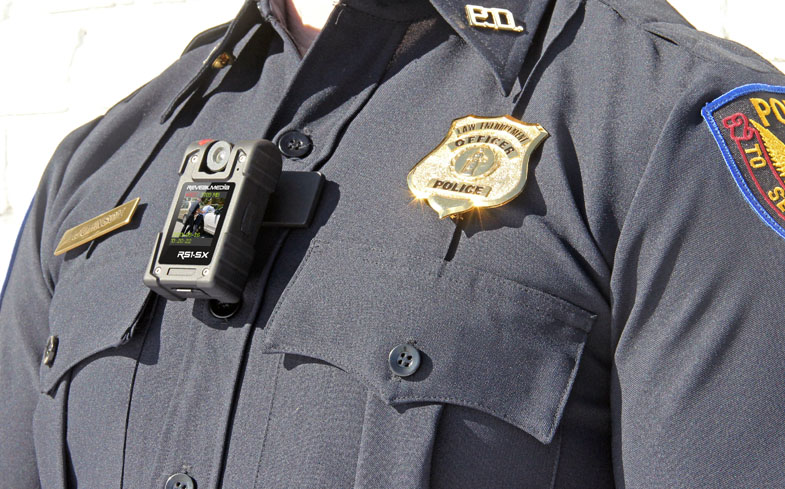
It was an unusually warm October night, and Patrolman Steven Wilson wasn’t thrilled when he arrived for the night shift to find his lieutenant holding a new device called a body camera that his department in South Euclid, Ohio, was trying out.
“I told him, ‘I don’t need this right away, it could wait until Monday, you didn’t have to stay later,” Wilson recalled. “None of the guys were excited about it. As I was getting hooked up, I was thinking, ‘This is just another way for someone to keep an eye on you.’”
The device, which connected to his police radio, weighed less than a pound. But on a Friday night toasty enough to wear short sleeves, the last thing the veteran cop wanted was yet another piece of gear to lug around.
“It was hanging from my left shoulder and I could definitely feel it,” Wilson said.
Several hours later, Wilson was glad his lieutenant didn’t wait.
Responding to reports of a domestic disturbance, Wilson fatally shot a man who was stabbing his ex-girlfriend and wouldn’t stop. It was the first time in a dozen years on the job he had killed anyone.
The harrowing footage captured on the WOLFCOM body camera connected to his police radio showed 44-year-old Ronnie McNary shouting “Kill me! Kill me!” and refusing to stop the bloody assault before Wilson opened fire.
“You can’t tell the story better,” Wilson told NBC News. “If you are a good police officer and you do what’s right, you won’t have any issues.”
While one of the biggest technological revolutions in the history of policing is still in its infancy, testimonials like Wilson’s are beginning to pile up in support of the tiny cameras, which are now being used by a quarter of the nation’s 17,000 police agencies, according to the ACLU. Taser, one of the leading manufacturers of body cameras, states on its website more than 3,500 U.S. police agencies had bought its Axon cameras alone as of September 2015.
The use of body cams by cops has broad bipartisan political support, with the Obama administration and members of both parties in Congress lined up behind a broad rollout of the devices, which run from $300 to more than $1,000.
They also are endorsed by many police officials, as well as most civil rights groups. And support among rank-and-file cops appears to be growing.
Supporters see them as promoting accountability for police officers as well as protecting them from unfounded accusations. Many also consider them critical to rebuilding public trust in the wake of a series of controversial police shootings of civilians — many of them black men.
President Barack Obama cited improving relations between police and minority communities when he requested $263 million to fund police body cameras and training in December 2014.
But not everybody is sold on the devices.
Black Lives Matter, which grew out of African-American outrage following the police slayings of Michael Brown in Ferguson, Missouri, Eric Garner on Staten Island, New York, and Walter Scott in North Charleston, South Carolina, among others, is not a fan.
Carmen Dixon, an organizer with the civil rights group’s New York City chapter and its spokesperson on the issue, says the cameras add to the militarization of cops, increase surveillance of law-abiding citizens and put the fox in charge of the henhouse by allowing police to control the “evidence” they produce. They also do nothing to correct the underlying problem of police officers unnecessarily resorting to force, she said.
“We saw Eric Garner murdered on videotape, we saw Walter Scott get murdered on videotape,” she said. “None of the videotaping has quelled systematic police violence.”
“The PBA’s concerns are centered on the need for clear and unambiguous policies so that our members, the NYC police officers, have clear guidance on when and how to use them,” PBA spokesman Al O’Leary said in an emailed response to questions from NBC News. “There also need to be policies in place controlling how the recordings will be used subsequently, who will have access to them and for what purpose.”
O’Leary said there is also concern that body cameras could hamper police investigations.
“Witnesses and victims of crimes might feel intimidated by the presence of a recording device which might make them less forthcoming with information,” he said.
He conceded, however, that 70 percent of PBA members in a recent survey said that body cameras “will allow for a more just resolution of complaints” against officers.
The union’s concerns initially were shared by many civil rights groups. But most major organizations – including the ACLU, NAACP, National Urban League and Voices for Racial Justice – endorsed the use of the new technology last year after agreeing to guidelines aimed at, among other things, preserving privacy, ensuring that cops can’t turn them off whenever they feel like it and protecting sexual assault victims and minors.
Sam Sinyangwe, co-founder of Campaign Zero, a group dedicated to ending police violence, said that the support was to some degree predicated on the fact that the technology already was flowing to law enforcers.
“For better or worse, we’re in a situation where lots of police departments are already using this technology,” he said. “It’s such a new technology that the jury is still out on this. But we do know that body cameras have been used to secure indictments against police officers. So it is promising.”
That promise has led the Department of Justice to award $23 million in grants to police departments in 32 states — including $1 million each to big departments in cities like Chicago, Detroit, Miami, Washington and Los Angeles — as part of a pilot program aimed at outfitting cops with body cameras.
DOJ spokeswoman Joan LaRocca told NBC News that the department is monitoring their use, but it is “premature to make an overall encompassing assessment on the devices at this point.”
Premature or not, advocates have been singing the praises of the cameras.
“We know that body cameras improve interactions between officers and the public and reduce the likelihood that force will be used,” Seattle Mayor Ed Murray said last year as he accepted a $600,000 federal grant to outfit the city’s police with cameras.
And that flow could become a torrent if Congress has its way.
Sen. Brian Schatz, D-Hawaii, introduced the Police Camera Act, which would fund more body camera pilot programs, in March 2015. And even in the politically polarized Senate, he had no problem gaining Republican support.
“Body cameras will benefit the brave men and women who serve in our police force and the people they protect,” Sen. Rand Paul, R-Kentucky, said in co-sponsoring the bill that is awaiting consideration in the Senate Judiciary Committee.
Enthusiasm for body cameras among law enforcement brass began building long before Michael Brown’s death in Ferguson.
The Rialto Police Department in Southern California became the first U.S. police force to take body cameras on a test drive in February 2012. For 12 months, 54 beat cops were randomly assigned to wear Taser HX Axon Flex video cameras during their 12-hour shifts.
The results were dramatic. Use-of-force incidents, which is when cops use muscle, weapons or dogs to subdue somebody, dropped by 60 percent, from an average of 65 in the three previous years to 25. And there appeared to be a spillover effect as a result of the cameras: just eight of those incidents involved officers wearing the cameras.
At the same time, public complaints against police officers plunged 88 percent.
The findings, detailed in a paper written by then-Rialto Police Chief Tony Farrar and two researchers from Cambridge University in England, caused a stir in law enforcement circles.
The City of Rialto was so satisfied with the results that it decided in February 2013 to spend $135,724.21 to outfit the department with the gear.
Three years later, Rialto Police Chief Randy De Anda says it was money well spent.
“We’re saving thousands of dollars on major court cases, our officers are spending much less time at trials and we’re saving a lot of money on litigation,” he said. “That’s money I can now spend on officer training, for example.”
De Anda said use-of-force complaints against Rialto’s uniformed officers, who are required to wear the cameras during all work in which they interact with the community, have declined 68 percent.
He said the cameras deter bad behavior by both citizens and officers and, as was the case with Officer Wilson, can prevent officers from being unfairly accused of wrongdoing.
He cited a ruckus last summer at a family party where relatives videotaped officers intervening to stop the fight and captured a shot of an officer punching a suspect.
“On Monday morning I got a complaint against the officer and I had to go over the video the family members submitted,” De Anda said. “Then I saw the officer’s tape and it gave the other side of the story. When I reviewed it, I realized that the suspect was the same guy who punched the officer in head.
“In the past, we only would have had the family’s footage and it would have been the officer’s word against that. We probably would have disciplined the officer based on that footage and settled out of court. Instead, we had evidence to charge the suspect with attacking our officer.”
The cameras do require a commitment of resources. Individual police departments have developed policies to protect witnesses and bystanders by blurring their images before making the video public. They also have grappled with how best to store and retrieve what’s expected to be an avalanche of evidence as use of the cameras spreads throughout departments.
But perhaps the biggest downside to the surging popularity of the body cams is being felt in the private sector.
Peter Austin Onruang, founder and president of WOLFCOM, one of the leading manufacturers of police body cams, said there were three or four suppliers when his company got into the business five year ago.
But after Obama’s funding request, the market “went crazy,” he said.
“Suddenly you have everybody and their brother selling body cameras and that has thrown confusion in the market,” said Onruang, who noted that in recent years his company has encountered new competition from companies peddling cheaper Chinese-made knock-offs.
Onruang said the rush to acquire the cameras has been fueled by growing acceptance among cops on the beat and on patrol.
At first, he said, it was “Big Brother peeking over their shoulder and all that. But as time progressed they began to see the benefits.”
Back in Ohio, Wilson said he understands why cops in New York City and elsewhere would have reservations about body cameras. But he reminds his brothers and sisters in blue that opinions can change in a flash.
“Police don’t really like change, especially when you question our integrity,” Wilson said. “I wasn’t sure about them either. I’m for them now.”
This article originally appeared on NBCNews.com.

